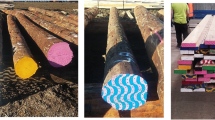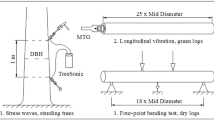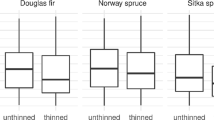Abstract
This study assesses whether acoustic velocity alone or in combination with information about the timber obtained in the forest or on the log-yard can be used for pre-sorting of Norway spruce (Picea abies [L.] Karst) structural timber. The study is based on 1235 boards from 205 trees sampled from 14 sites in Norway. In addition to various site-, tree- and log variables, acoustic velocity was obtained by Fibre-gen tools, the ST300 on standing trees and the HM200 on logs. Both ST300 and HM200 explained parts of the variability of the indicating property measured by Dynagrade strength grading machine, but the accuracy was better for HM200 than for ST300. The model with ST300 was substantially improved by introducing forest data, i.e., height to diameter ratio, age and relative longitudinal position in the tree while the improvement by combining HM200 with log data, i.e., log tapering, was minor. Grade yield after pre-sorting based on the developed models was simulated, and the results showed a possibility of increasing the C30 yield. The results show that acoustic velocity could be used either as an inventory tool, to give information about the available material from a site, or as a pre-sorting tool before sawing the logs to certain products.



Similar content being viewed by others
References
Atmer B, Thörnqvist T (1982) The properties of tracheids in spruce (Picea abies Karst.) and pine (Pinus sylvestris L.). Reports No. 134, Swedish university of agricultural sciences [in Swedish with English summary]
Auty D, Achim A (2008) The relationship between standing tree acoustic assessment and timber quality in Scots pine and the practical implications for assessing timber quality from naturally regenerated stands. Forestry 81(4):475–487
Boström L (1997) Assessment of Dynagrade timber strength grading machine. Technical Report, Swedish National Testing and Research Institute Building Technology
Brännström M (2009) Strength grading for sawmill. BioResources 4(4):1430–1454
Brännström M, Oja J, Grönlund A (2007) Predicting board strength by X-ray scanning of logs: the impact of different measurement concepts. Scand J Forest Res 22(1):60–70
Brüchert F, Wilhelmsson L, Mochan S, Sauter UH (2011) An integrated approach for wood quality prediction from standing tree to sawn timber. In: Divos F (Ed) Proceedings 17th International Nondestructive Testing and Evaluation of Wood Symposium, Sopron Hungary, pp 40–47
Carter P, Chauhan SJW (2006) Sorting logs and lumber for stiffness using director HM200. Wood Fiber Sci 38:49–54
Carter P, Xiping W, Ross RJ (2013) Field application of processor head acoustic technology in forest harvest operations. In: Ross RJ; Wang X (Eds) Proceedings 18th International Nondestructive Testing and Evaluation of Wood Symposium, Madison USA, pp 7–14
Dickson RL, Matheson AC, Joe B, Ilic J, Owen JV (2004) Acoustic segregation of Pinus radiata logs for sawmilling. New Zeal J For Sci 34(2):175–189
Dynalyse AB (2010) Dynagrade—English manual. Partille, Sweden
Edlund J, Lindstrom H, Nilsson F, Reale M (2006) Modulus of elasticity of Norway spruce saw logs versus structural lumber grade. Holz Roh Werkst 64(4):273–279
Eikenes B, Kucera B, Fjærtoft F, Storheim ON, Vestøl GI (1996) Virkeskvalitet i fleraldret skog [Wood quality from uneven-aged forests]. Rapp Skogforsk 24(95):1–30
Foslie M, Moen K (1968) Norsk granvirkes styrkeegenskaper. 1. Bøyestyrke, elastisitetsmodul og strekkstyrke målt på 3”x8” og 2”x4” [Strength properties of Norwegian Spruce. 1. Bending strength, modulus of elasticity and tensile strength tested on the structural sizes 3”x8” og 2”x4”]. vol 33. NTI, Oslo
Gao S, Wang X, Wang L, Allisson RB (2012) Effects of temperature on acoustic effects of standing trees and logs: part 1—laboratory investigations. Wood Fiber Sci 44(3):1–12
Gao S, Wang X, Wang L, Allisson RB (2013) Effect of temperature on acoustic evaluation of standing trees and logs: part 2: field investigation. Wood Fiber Sci 45(1):1–11
Gao S, Wang X, Wang L (2014) Modeling temperature effect on dynamic modulus of elasticity of red pine (Pinus resinosa) in frozen and non-frozen states. Holzforschung. doi:10.1515/hf-20114-0048
Grabianowski M, Manley B, Walker JCF (2006) Acoustic measurements on standing trees, logs and green lumber. Wood Sci Technol 40(3):205–216
Grace LA (1993) Exploring the potential of using optical log scanners for predicting lumber grade. Forest Prod J 43(10):45–50
Haartveit EY, Flæte PO (2002) Mechanical properties of Norway spruce lumber from monocultures and mixed stands—modelling bending stiffness and strength using stand and tree characteristics. In: Nepveu G (ed) Connection Between Silviculture and Wood Quality: Modelling Approaches and Simulation Software, IUFRO WP S5.01-04 Workshop, Harrison Hot Springs, British Columbia, Canada
Høibø OA (1991) The quality of wood of Norway spruce (Picea abies (L.) Karst) planted with different spacing. Dissertation, Agricultural University of Norway
Høibø O, Vestøl GI, Fischer C, Fjeld L, Øvrum A (2014) Bending properties and strength grading of Norway spruce: variation within and between stands. Can J Forest Res 44:128–135
Jäppinen A, Beauregard R (2000) Comparing grade classification criteria for automatic sorting of Norway spruce saw logs. Scand J Forest Res 15(4):464–471
Kantola A, Makinen H, Makela A (2007) Stem form and branchiness of Norway spruce as a sawn timber—predicted by a process based model. Forest Ecol Manag 241(1–3):209–222
Kollmann FFP, Côté WA (1968) Principles of Wood Science and Technology, vol 1. Springer, Berlin, Heidelberg
Kuçera B (1994) A hypothesis relating to annual height increment to juvenile wood formation in Norway spruce. Wood Fiber Sci 26(1):152–167
Lackner R, Foslie M (1989) Spruce from Western Norway. Working report, Norwegian Institute of Wood Technology [In Norwegian with English summary]
Lindström H, Reale M, Grekin M (2009) Using non-destructive testing to assess modulus of elasticity of Pinus sylvestris trees. Scand J Forest Res 24:247–257
Littell RC (2006) SAS for mixed models. SAS Institute Inc., Cary
Mäkinen H, Colin F (1998) Predicting branch angle and branch diameter of Scots pine from usual tree measurements and stand structural information. Can J Forest Res 28(11):1686–1696
Moore JR, Lyon AJ, Searles GJ, Lehneke SA, Ridley-Ellis DJ (2013) Within- and between-stand variation in selected properties of Sitka spruce sawn timber in the UK: implications for segregation and grade recovery. Ann For Sci 70:403–415
Oja J, Grundberg S, Grönlund A (2001) Predicting the stiffness of sawn products by X-ray scanning of Norway spruce saw logs. Scand J Forest Res 16(1):88–96
Oja J, Kallsner B, Grundberg S (2005) Predicting the strength of sawn wood products: a comparison between x-ray scanning of logs and machine strength grading of lumber. For Prod J 55(9):55–60
Øvrum A (2013) In-forest assessment of timber stiffness in Norway spruce (Picea abies (L.) Karst.). Eur J Wood Prod 71:429–435
Paradis N, Auty D, Carter P, Achim A (2013) Using a standing-tree acoustic tool to identify forest stands for the production of mechanically-graded lumber. Sensors 13:3394–3408
Perstorper M (1999) Dynamic testing of logs for predicting of timber strength. Proceedings of the Pacific timber engineering conference. Rotorua, New Zealand, pp 70–74
Rais A, Pretzsch H, van de Kuilen J-WG (2014) Roundwood pre-grading with longitudinal acoustic waves for production of structural boards. Eur J Wood Prod 72:87–98
Ridoutt BG, Wealleans KR, Booker RE, McConchie DL, Ball RD (1999) Comparison of log segregation methods for structural lumber yield improvement. For Prod J 49(11–12):63–66
Searles GJ (2012) Acoustic segregation and structural timber production. Dissertation, Edinburgh Napier University
Standard Norge (2009a). Konstruksjonstrevirke—Fasthetsklasser [structural timber—strength class]. Norsk Standard NS-EN 338
Standard Norge (2009b) Trekonstruksjoner—Styrkesortert konstruksjonstrevirke med rektangulært tverrsnitt—Del 4: Maskinell styrkesortering—Innstillingsverdier for maskinkontrollerte systemer [Timber structures—strength graded structural timber with rectangular cross section—part 4: machine grading—grading machine settings for machine controlled systems]. Norsk Standard NS-EN 14081-4
Standard Norge (2010) Trekonstruksjoner—Styrkesortert konstruksjonstrevirke med rektangulart tverrsnitt—Del 2: Maskinell sortering; Tilleggskrav forinnledende typeproving [Timber structures—strength graded structural timber with rectangular cross section. Part 2. Machine grading; additional requirements for initial type testing]. Norsk Standard NS-EN 14081-2
Standard Norge (2011) Trekonstruksjoner—Styrkesortert konstruksjonstrevirke med rektangulart tverrsnitt—Del 1: Generelle krav [Timber structures—strength graded structural timber with rectangular cross section. Part 1. General requirements]. Norsk Standard NS-EN 14081-1
Tamminen Z (1964) Moisture content, density and other properties of wood and bark. II. Norway spruce. Report No.47, Royal College of Forestry, Department of Forest Products [In Swedish with English summery]
Tsehaye A, Buchanan AH, Walker JCF (2000a) Selecting trees for structural timber. Holz Roh Werkst 58(3):162–167
Tsehaye A, Buchanan AH, Walker JCF (2000b) Sorting of logs using acoustics. Wood Sci Technol 34(4):337–344
Tveite B (1977) Site–index curves for Norway Spruce (Picea abies (L.) Karst.). Norwegian Research Forest Institute Rapport 33(1)
Unterwieser H, Schickhofer G (2012) Influence of temperature and moisture content on the dynamic properties of ungraded spruce boards. Eur J Wood Prod 70(5):629–638
Vestøl GI, Høibø O, Langsethagen KG, Skaug E, Skyrud REA (2012) Variability of density and bending properties of Picea abies structural timber. Wood Mat Sci Eng 7(2):76–86
Walsh D, Strandgard M, Carter P (2014) Evaluation of the Hitman PH330 acoustic assessment system for harvesters. Scand J Forest Res 29(6):593–602
Wang X (2013) Acoustic measurements on trees and logs: a review and analysis. Wood Sci Technol 47:965–975
Wang X, Verrill S, Lowell E, Ross RJ, Herian VL (2013) Acoustic sorting models for improved log segregation. Wood Fiber Sci 45(4):343–352
Wilhelmsson L (2001) Characterisation of wood properties for improved utilization of Norway spruce and Scots pine. Dissertation, Swedish University of Agricultural Sciences
Wilhelmsson L, Arlinger J, Spangberg K, Lundqvist SO, Grahn T, Hedenberg O, Olsson L (2002) Models for predicting wood properties in stems of Picea abies and Pinus sylvestris in Sweden. Scand J For Res 17(4):330–350
Zobel BJ, van Buijtenen JP (1989) Wood variation: its causes and control. Springer, Berlin
Acknowledgments
This study is part of the national project “Tresterk”. The project is financed by the Research Council of Norway (Grant no. 208085/I10), Fondet for Treteknisk Forskning, Skogtiltaksfondet and the Norwegian forest industry. The Norwegian University of Life Sciences also supported the work.
Author information
Authors and Affiliations
Corresponding author
Rights and permissions
About this article
Cite this article
Fischer, C., Vestøl, G.I., Øvrum, A. et al. Pre-sorting of Norway spruce structural timber using acoustic measurements combined with site-, tree- and log characteristics. Eur. J. Wood Prod. 73, 819–828 (2015). https://doi.org/10.1007/s00107-015-0946-5
Received:
Published:
Issue Date:
DOI: https://doi.org/10.1007/s00107-015-0946-5




